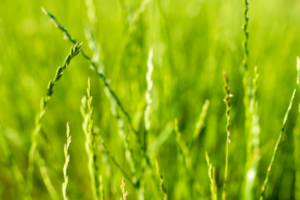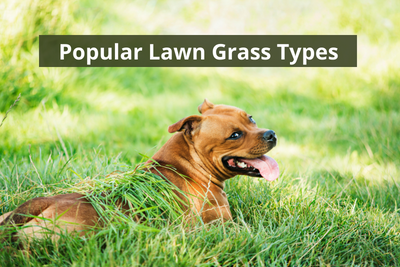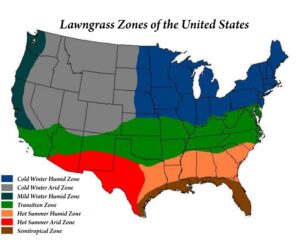If you’re like most people, you define a healthy and beautiful lawn this way: the grass is green and thick, cut to a neat height, devoid of bare spots; there isn’t a weed in sight. Many homeowners don’t give it more thought than that. They may have inherited the type of grass that came with the lot.
This article will look at the most popular grass seeds by region and show you which are the easiest to maintain, are aesthetically pleasing, and are the most water-efficient.
Whether you’re establishing a new lawn or maintaining your existing landscape, there are several types of turfgrass to choose from, the most popular of which depend on where you live.
You probably know that there are two main kinds of seed: cool-season grasses and warm-season grasses. But you may be less aware that the U.S. Department of Agriculture has broken down the country into climatic zones to help you determine climate limits of a particular grass and help you choose a seed that will thrive and strive summer and winter, year after year.
They are called lawn grass zones. They are categorized by cool- or warm-season and transitional zones; and are further broken down into sub-categories to account for a region’s humid or arid climate. The best grass types in a category are determined by tolerance and growing ability.
COOL-SEASON ZONES
 Cool-season zones, generally in the northern part of the country, have bitter cold winters and warm-to-hot summers. These climates typically see regular intervals of rainfall during summer months, but can experience extended periods of dry weather, even drought conditions.
Cool-season zones, generally in the northern part of the country, have bitter cold winters and warm-to-hot summers. These climates typically see regular intervals of rainfall during summer months, but can experience extended periods of dry weather, even drought conditions.
Grasses that thrive in these zones include Kentucky bluegrass, tall and red fescues, perennial ryegrass, buffalograss.
These grasses can withstand wide temperature ranges; they go dormant, then resume growing when the weather gets cooler and wetter.
WARM-SEASON ZONES
 These zones are found in the south and southwestern regions of the Lower 48 and include a semi-tropical zone that slices from Florida along the Gulf coast into Texas. These climates are hot and humid during the summer months. Grasses that do well in these zones will flourish into thick green lawns in the stifling heat, then go dormant and turn brown during the fall and winter.
These zones are found in the south and southwestern regions of the Lower 48 and include a semi-tropical zone that slices from Florida along the Gulf coast into Texas. These climates are hot and humid during the summer months. Grasses that do well in these zones will flourish into thick green lawns in the stifling heat, then go dormant and turn brown during the fall and winter.
Grasses that do well include Bermuda, Centipede, Zoysia, St. Augustine.
To maintain a lawn with a green color year round, some homeowners in the south may winter overseed with ryegrass.
TRANSITION ZONE
 Between the northern and south regions, the government carved out what it calls a transition zone: it tracks along lower elevations of Virginia and North Carolina west through West Virginia, Kentucky, Tennessee, and into Arkansas; it includes southern Ohio, Indiana, Illinois, Missouri and Kansas.
Between the northern and south regions, the government carved out what it calls a transition zone: it tracks along lower elevations of Virginia and North Carolina west through West Virginia, Kentucky, Tennessee, and into Arkansas; it includes southern Ohio, Indiana, Illinois, Missouri and Kansas.
The transition zone is distinguished by the unique climate: neither cool- nor warm-season grasses grow uniformly or consistently well. Choosing the right seed variety is trickier in this region.
Kentucky bluegrass, perennial ryegrass and tall fescue do well from Virginia to West Virginia and Kentucky to Missouri.
Tall fescue and Bermuda work best from North Carolina to Tennessee and northern Georgia, northern Alabama and into the Texas panhandle. Warm-season grasses also perform well in the lower elevations of these states.
You can pinpoint exactly in which zone you live by going to the U.S. Department of Agriculture’s interactive map here: https://planthardiness.ars.usda.gov.


